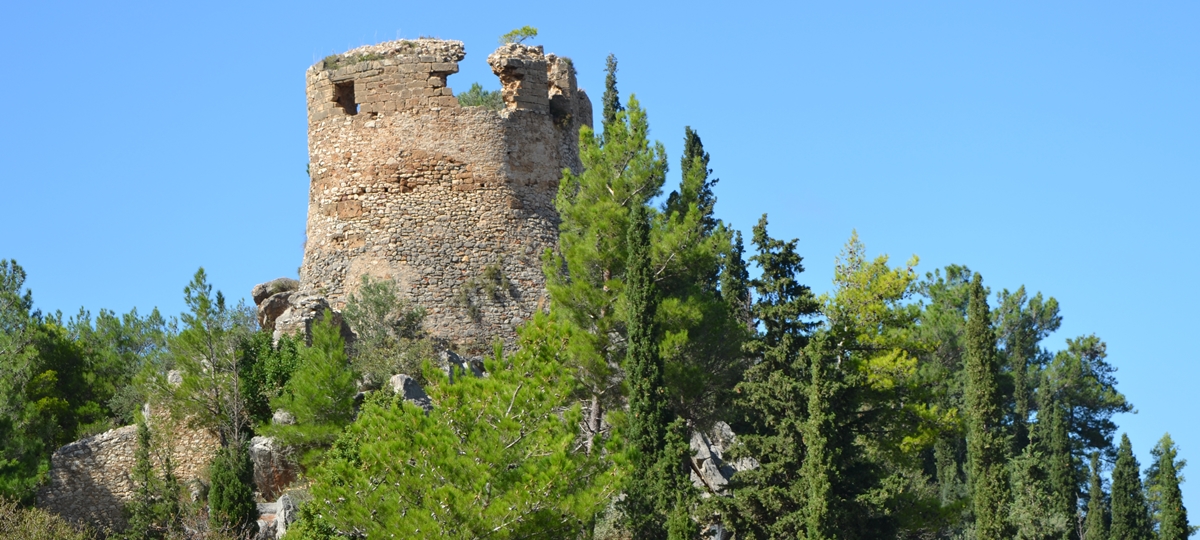KYPARISSIA

PLEASE NOTE THAT ALL THE PHOTOGRAPHS ON THE SITE ARE CLICKABLE LINKS

PLEASE NOTE THAT ALL THE PHOTOGRAPHS ON THE SITE ARE CLICKABLE LINKS
The Castle is Byzantine built around the 11th century, sited on top of a steep hill above the north-west end of the Old (Upper) Town of Kyparissia, probably at the location of the ancient Mycenean acropolis of Cyparissia.
The Castle of Kyparissia is also known as the Castle of Arcadia, which is the medieval name of the town as numerous Arcadians moved there.
In mythology the citadel of Kyparissia was built by "Giants". Some of the stones with which the castle is built are enormous, some are 4m in length and 1.64m wide, others are 1.38m long and 1.80m wide.
Four walls were built at the four corners of the castle by the Byzantines, but only one is preserved today, which is named "Ioustinianos", after the great Byzantine emperor.
During the first decades of the 13th century, the castle fell to the Franks who renovated it then it remained in their hands for the next 2 centuries.
The Barony of Arcadia was not one of the original twelve secular baronies of the Principality. Initially, Arcadia formed part of the princely domain of the Villehardouin family.
It was created as a separate barony by the Prince of Achaea Guillaume II de Villehardouin shortly after the Byzantine reconquest of Constantinople in 1261, to recompense Vilain d'Aulnay, one of the Frankish lords of the Latin Empire of Constantinople who sought refuge in Achaea.
After Vilain's death in 1269, the barony was divided between his sons, Erard and Geoffrey. Erard disappears after 1279, when he was captured by the Byzantines, but Geoffrey did not manage to reclaim his brother's portion until 1293, due to the obstructions of the Angevin baillis, who sequestered the domain.
He was succeeded in 1297 by Vilain II, who was in turn succeeded by his two children, Erard II and Agnes. Erard II died some time before 1338, but Peter dalle Carceri, Triarch of Negroponte, was already attested as lord of half the barony in 1324.
It is assumed that Erard II left his half of the barony to his widow, Balzana Gozzadini, who took Peter as a second husband. Balzana died soon after.
Erard's sister Agnes married in 1324 Stephen le Maure (The Moor), Lord of Saint-Sauveur (or Saflaouro) and Aetos, and had a son, Erard III, who by 1344 managed to reunite the barony, and was named marshal of Achaea in 1345. He became one of the most powerful Frankish lords of his time.
In 1348, a Burgundian knight, Louis of Chafor, with some companions, managed to take over the castle of Arcadia and hold Erard's wife and children captive until Erard paid a large ransom.
Erard was succeeded in 1388 by one of his daughters, who married Andronikos Asanes Zaccaria, and the barony became a possession of the Zaccaria family (who were Genoans from Chios island).
Andronikos Asanes Zaccaria died in 1401 and the castle of Arcadia was inherited by one of his four sons, probably Centurione Zaccaria who in 1404 became (the last) Prince of Achaea.
So, the castle of Kyparissia was the last Frankish castle of Moreas and the stage of the last act of the over 200 years Frangokratia (Frankish occupation) in Morea.
In 1432, the castle became part of the Byzantine domain of the Despotate of Morea. This lasted only until 1460 when most castles of Peloponnese including Arcadia were captured by the Turks under Mehmed II the Conqueror.
The Turks used the castle and made some minor modifications. They held it until 1685 when the whole of Peloponnese was occupied by the Venetians. It was the second Venetian period of Peloponnese which lasted until 1715.
The Venetians had probably used the castle but contrary to their practice in other occupied castles, did not reinforced the fortification in the castle of Arcadia.
The Turks came back in 1715. The castle was taken by the Greeks on 25th March 1821 the first day -officially- of the Greek War of Independence.
In 1825 Arcadia was looted by the army of Ibrahim pasha. The Ottomans permanently left the town and its castle around 1828.
The castle was seriously damaged during the Greek War of Independence,
In 1970, the castle was partly restored. A small open-air theatre was built, which now hosts cultural events in the summer, such as musical concerts, poetry nights and ancient tragedies.
Over the centuries, the castle of Kyparissia has stood above the town , offering vistors not only a spectacular view of the town, but also the whole of Kyparissia Bay.